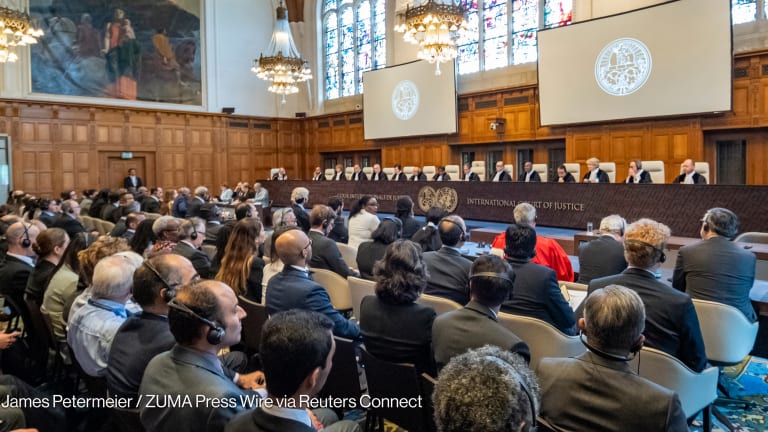
LONDON — When it comes to climate change, small island nations are some of Earth’s most imperiled places. With much of their populations just a few meters above sea level, they are particularly exposed to the related threats, from extreme weather and storm surges to coral bleaching and coastal erosion.
Small island developing states are on the frontline of climate change impacts. This series looks at the innovative solutions and satellite technology helping prepare and build resilience among some of the world’s most vulnerable communities.
One way to mitigate the potentially devastating impacts on island communities is by harnessing satellite data. However, these countries sometimes consist of hundreds of islands and face connectivity challenges, making it a major endeavor to share data with more remote locations.
A project called CommonSensing is therefore seeking to address this challenge in collaboration with national ministries, local research, and community planning institutes, and NGOs.
“We want to make sure we don’t only provide technical solutions, but also develop the capacity in-country to make use of these tools.”
— Einar Bjorgo, manager, UNOSAT, and project director, CommonSensingThe three-year initiative, launched in February 2018, is harnessing satellite remote sensing in three Commonwealth countries — Fiji, the Solomon Islands, and Vanuatu — to make data relating to climate risks and disasters available through a web portal and mobile applications. The idea is to make the outputs sustainable beyond the end of the project and help these nations use the data to build resilience and better secure funding for climate change mitigation.
CommonSensing is led by the Operational Satellite Applications Programme, or UNOSAT, which is run by the United Nations Institute for Training and Research and provides satellite-based geospatial information to relief and development organizations. The project is working with local ministries and also includes partners such as the Commonwealth Secretariat and the Met Office.
Speaking to Devex, Einar Bjorgo, manager at UNOSAT and project director of CommonSensing, details the big climate-related threats faced by small island developing states, or SIDS, how technology can aid them, and the key role CommonSensing is playing to this end.
This conversation has been edited for length and clarity.
What are the biggest threats that climate change poses to SIDS?
What is the International Partnership Programme?
The UK Space Agency’s International Partnership Programme is a £152 million ($199 million) multiyear program launched in 2015, which uses U.K. organizations’ space knowledge, expertise, and capability to provide a sustainable, economic, or societal benefit to low- and middle-income countries. It is funded by the Department for Business, Energy & Industrial Strategy’s Global Challenges Research Fund, a £1.5 billion fund which forms part of the U.K. government’s official development assistance commitment.
Tropical cyclones and storms that hit them are increasing in frequency and destructive power. Sea-level rise also means that storm surges tend to have a much bigger effect than they used to. This can affect the coastline and destroy communities, posing another challenge of relocation within islands — an issue we’re looking at. These factors are also affecting food security through destruction of crops.
At the other end of the scale, some countries are reporting increasing droughts — so it’s not only about the destructive forces of heavy mega-events, but also longer-term, slow-onset emergencies.
How are these issues being addressed by technology and what challenges are involved?
Clearly technology is little by little being applied. Today, we have a good understanding of the issues at stake and technology is slowly being developed to help tackle these. However, there has to be an update of these solutions at the decision-making level and so our efforts also need to be focused there.
It is important for the countries to make use of technology because, for example, many have outdated maps of certain areas. They may not have up-to-date information about urban and agricultural areas or road networks, hampering sustainable planning for resilience to climate change.
Another problem is having the pure capacity at a national level to collect information, update it and carry on this work, even if the technology is available. That is why in the UNOSAT program, we want to make sure we don’t only provide technical solutions, but also develop the capacity in-country to make use of these tools.
You do not develop capacity by doing a two-week training program; we’re aiming to be there in the country with them. This is about sitting in the ministry day in, day out and making sure that, little by little, they use this technology, and through that, gain access to funding to improve their resilience to climate change.
We are also working with our project partners, such as the Commonwealth Secretariat’s Climate Finance Access Hub and Radiant Earth Foundation, to make sure this is sustainable when the project is over.
What kind of tools are you offering?
We will use tools such as “data cubes” — huge data sets of satellite imagery that you can stack on top of each other at different dates to give a historical record of Earth data. With these, you can analyze trends in different thematic areas, such as agriculture, urban development, and coastal erosion.
You can then look at factors such as hazard exposure: For example, if you have significant urban development around cities, how exposed are they to the changing climate? Using the historical data combined with climate forecasts, how will that affect vulnerability at the local level in urban areas? And do people need to be moved from a distant island that is no longer secure? When the government needs to move people, it can also use the data cubes to look at suitable areas.
Furthermore, we are modeling the effects of climate change on agriculture, helping countries decide which crops should be grown where to have as food-secure a community as possible.
We want the data developed in the project to be free and open source.
What are the challenges in getting data to people in SIDS?
One challenge is that it’s quite uneven in terms of the amount of data available already. Some countries are more advanced than others — but that is also where we can have the biggest impact.
For now, some countries also have poor, unstable internet connections. Fiber-optic cables and other technologies are, however, being rolled out little by little to reach the SIDS and internet access will come to those who are currently furthest behind.
In the meantime, there are solutions to help get round this situation so we can provide them with data. Where data streaming is not possible, we are looking at alternatives, such as installing the data on national servers — even if it means copying from hard drives. That will mean some solutions will be limited and the information may not be as up-to-date as we want, but at least the countries will have tools and technologies adapted to their current settings while waiting for more powerful internet connections.
How well are all the different parties, such as satellite providers, ministries, research institutions, and NGOs, working together to help provide geoinformation to SIDS?
One thing is clear — there’s a lot of stuff going on in the region within this domain of geoinformation and imagery. There’s a very positive atmosphere among the projects, with many excellent regional actors that have a lot of experience and can help guide us.
We have had four missions to the region already. We have met with and mapped out the stakeholders and ongoing projects, and they all say the same thing: “Let’s make sure we do things in a well-coordinated manner.” And that is what we want to do. So we are definitely playing our part in sharing data and information. I think it’s really a trend now — people have realized that you cannot keep your data to yourself, thankfully.
We are quite amazed by the level of interest in the project internationally, but also at a national level. I’ve never been in a project in which we are able to so readily access ministers, speak to them and they immediately get it and are very supportive. This positive reception at the country level has been quite overwhelming. Now we start to deliver.
Visit the Turning the Tide series here for more coverage on climate change, resilience building, and innovative solutions in small island developing states. You can join the conversation using the hashtag #TurningtheTide.

Update June 21, 2019: This article has been updated to clarify the name of the Met Office.








